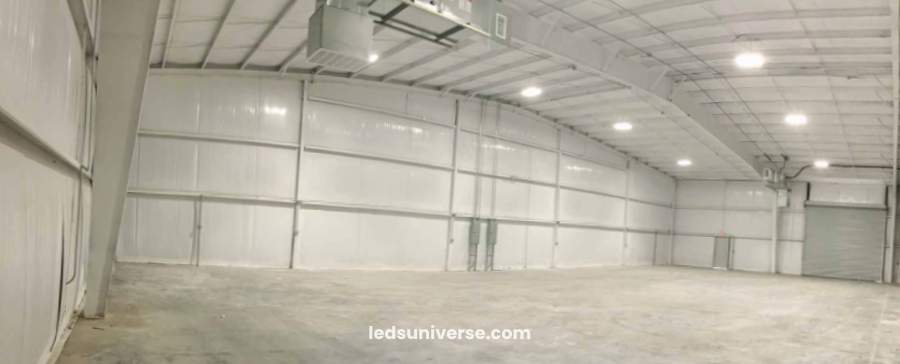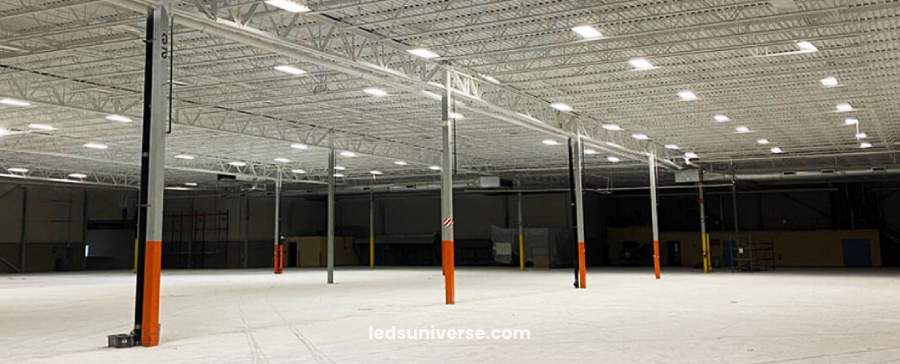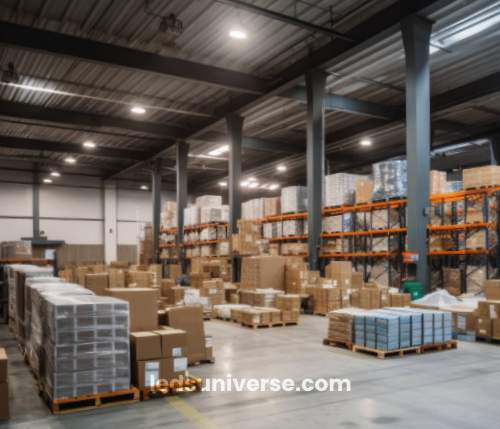In retail stores, warehouses, and workshops, effective lighting transforms the space, making it brighter and more inviting. Low bay lighting, designed for ceilings between 12 and 20 feet high, plays a key role in achieving this by spreading light evenly and eliminating harsh shadows. It ensures that every detail is visible, whether showcasing products or guiding workers through busy aisles. With the right setup, low bay lighting creates an environment where tasks are performed efficiently and spaces feel welcoming.
One of the key types of lighting used in environments with lower ceilings is low bay lighting. This page provides a detailed exploration of low bay lighting, discussing its characteristics, applications, advantages, and maintenance considerations, while offering insights into why it is a preferred option for many businesses and institutions.
Reach out for free lighting consultation
Table of Contents
ToggleLow bay lighting refers to lighting solutions specifically designed for areas with ceiling heights ranging from 12 to 20 feet. These lighting fixtures are optimized to distribute light evenly across a space without causing glare or over-illumination. Low bay lights are ideal for spaces where high-intensity lighting would be too harsh or inefficient, and where proper illumination is essential for functionality, safety, and comfort.
The primary applications of low bay lighting include retail stores, warehouses, educational facilities, and public spaces where the ceiling height is moderate. Understanding the unique requirements of these environments is key to selecting and maintaining an efficient low bay lighting system.

Low bay lighting is designed to meet the lighting needs of spaces with ceilings between 12 to 20 feet. This height is critical in distinguishing low bay lighting from high bay lighting, which is typically used for ceilings over 20 feet. The lower height necessitates a different approach to lighting design, focusing on a more diffused, wide-angle light distribution. Unlike high bay lights, which project intense beams over long distances, low bay lights aim to spread light more evenly over shorter distances.
The lumen output and beam angle of low bay lights are crucial factors in their design. Low bay fixtures typically have a lower lumen output than their high bay counterparts to avoid overpowering the space with excessive brightness. Additionally, they use a wider beam angle to distribute light more evenly across the floor or workspace. This wider spread reduces harsh shadows and minimizes glare, which can be distracting or even dangerous in working environments.
Low bay lighting fixtures are available in various color temperatures, generally ranging from 4000K to 5000K. This range provides a natural, bright white light that is both comfortable for the eyes and suitable for a variety of tasks. Additionally, many low bay lights offer a high Color Rendering Index (CRI), which ensures that colors appear natural and clear under the light. High CRI is particularly important in retail or work environments where the accurate representation of colors is necessary for tasks such as reading, assembly, or product presentation.
One of the most critical elements in low bay lighting design is the installation height of the fixtures. Low bay lighting is typically used for ceilings between 12 and 20 feet, as higher ceilings would require more powerful high bay lights to ensure adequate coverage. The lower height allows for a wider distribution of light, which is essential for even illumination.
| Ceiling Height | Lighting Design Guidelines |
|---|---|
| 12 to 16 feet | Lights should be mounted closer to the ceiling (e.g., 10-12 feet from the floor) to provide wide light distribution without harsh shadows. The ideal fixture placement and number of fixtures will depend on the lumens output and coverage area. Typically, lower-wattage fixtures (e.g., 100W LEDs) with a wide beam angle (90-120 degrees) work well. Spacing should be around 12-15 feet for even coverage. |
| 16 to 20 feet | Slightly more powerful fixtures (e.g., 150-200W LEDs) may be needed to maintain even illumination. The lights should be mounted at the higher end of the ceiling range, around 15-18 feet, to avoid overly bright spots directly under the lights. Narrower beam angles (60-90 degrees) are often preferred to focus light downward. Spacing between fixtures can be 15-24 feet, depending on the lumen output and area size. |
In both cases, it’s essential to choose fixtures that can distribute light evenly across the area and to adjust the height based on the specific needs of the space.
Lux is the measurement of light intensity as perceived by the human eye and is crucial in low bay lighting design. It measures how much light falls on a surface (lumens per square meter), with different spaces requiring different lux levels depending on the tasks being performed.
Typical lux requirements for various environments are:
| Application | Recommended Lux Level (Illumination Intensity) |
|---|---|
| Warehouses and Storage Spaces | 150-300 lux |
| Workshops and Assembly Lines | 300-500 lux |
| Retail Spaces and Supermarkets | 500-750 lux |
| Classrooms and Gyms | 300-500 lux |
In low bay lighting design, achieving the correct lux levels is vital to ensure that workspaces are adequately illuminated. Higher lux levels are necessary for task-intensive environments like assembly areas, while lower lux levels are suitable for storage or other non-detailed workspaces.

Proper spacing between fixtures is key to preventing dark spots or overly bright areas. The spacing depends on factors such as the type of fixture, the lumen output, and the height at which the lights are installed.
A common rule of thumb for low bay lighting is that the spacing between lights should be approximately 1 to 1.5 times the installation height for uniform light distribution.
| Ceiling Height | Recommended Fixture Spacing | Example |
|---|---|---|
| 12 feet | 12 to 18 feet apart | In a retail store with 12-foot ceilings, fixtures may be spaced closer, around 10 to 12 feet, for higher lux levels and product visibility. |
| 16 feet | 16 to 24 feet apart | In a warehouse with 16-foot ceilings, 150-watt LED low bay fixtures spaced about 20 feet apart ensure even light coverage and avoid dark zones. |
Poorly spaced fixtures can lead to uneven illumination, which can result in shadows that make it difficult for workers or customers to move around or perform tasks efficiently.
Low bay lighting fixtures typically come in various beam angles, which control how widely or narrowly the light is spread. Wide beam angles (60-120 degrees) are most appropriate for low bay applications, as they distribute light over a broader area. The wider distribution ensures that the entire space is uniformly lit, which is especially important in environments such as retail stores or gyms where consistent illumination is required across a large area.
Choosing the correct beam angle depends on the ceiling height and the specific lighting needs of the area.
| Ceiling Height | Recommended Beam Angle | Application |
|---|---|---|
| 12 feet | 90-120 degrees | Ideal for widespread coverage in retail or general workspaces, ensuring uniform light distribution across the area. |
| 16 to 20 feet | 60-90 degrees | More suitable for focusing light downward in warehouses or assembly lines, maintaining adequate floor-level illumination. |
The materials used in the construction of the space can influence how light is reflected and distributed. Highly reflective surfaces, such as white or light-colored walls, ceilings, and floors, can improve the overall brightness of the space, allowing for fewer fixtures or lower wattage lighting to be used. Conversely, dark surfaces absorb more light, necessitating more powerful lighting to achieve the desired lux levels.
In warehouses with white-painted ceilings, for example, the reflective nature of the surface can enhance light distribution and improve uniformity. This can reduce the number of fixtures needed to achieve the same illumination as in spaces with darker, more light-absorbing surfaces.
LED technology is the most popular choice for low bay lighting due to its superior energy efficiency, long lifespan, and better light quality. LED low bay lights consume significantly less energy compared to traditional lighting options like fluorescent or incandescent lights. Additionally, they produce less heat, making them safer and more comfortable for use in confined spaces. LED lights also offer a longer lifespan, which reduces the need for frequent replacements and maintenance. Moreover, their brightness is consistent over time, and they are less prone to flickering, making them ideal for environments where consistent lighting is essential.
Fluorescent lighting was once the standard option for low bay applications due to its affordability and widespread availability. While it remains a viable option for certain settings, it is generally less efficient and durable than LED lighting. Fluorescent low bay lights tend to consume more energy and have a shorter lifespan. Additionally, their performance may degrade over time, resulting in flickering or reduced brightness, which can negatively impact productivity and comfort in a space. However, for businesses looking for a lower upfront cost, fluorescent lighting can still be a cost-effective solution.
Induction lighting is another option, though less common than LED or fluorescent lights. Induction lights use electromagnetic fields to generate light, resulting in a long lifespan and reduced maintenance needs. However, their adoption has been slower due to the higher initial cost and less widespread availability. Induction lights are ideal for environments where maintaining lighting fixtures is difficult, such as areas that are hard to access or spaces requiring infrequent maintenance.
In commercial spaces such as retail stores, supermarkets, and showrooms, proper lighting is essential to create a pleasant shopping environment and highlight products effectively. Low bay lighting is ideal for these spaces due to its ability to evenly distribute light over a wide area, ensuring that shelves, aisles, and product displays are well-lit. This not only enhances the visual appeal of products but also improves the customer experience by making it easier to navigate the space.
Retailers often prefer low bay lighting because it offers the right balance between brightness and comfort, preventing glare while ensuring that products are visible in their true colors. The use of LED low bay lighting in particular can lead to significant energy savings, which is an important consideration for large stores that need to keep operating costs low.

In industrial settings and warehouses, low bay lighting is crucial for ensuring worker safety and productivity. Low ceiling areas, such as packing stations, assembly lines, or storage areas, require consistent and even lighting to minimize accidents and ensure efficient workflow. In these environments, glare and uneven lighting can pose serious safety risks, especially when workers are handling heavy machinery or sensitive tasks.
Low bay lighting in industrial settings is often installed with durability and longevity in mind, especially in areas that may be exposed to dust, moisture, or temperature fluctuations. LED low bay lights are particularly popular in industrial environments because of their resilience, long lifespan, and reduced maintenance needs.
Schools, gyms, community centers, and other public spaces often utilize low bay lighting due to its cost-effectiveness and versatility. In these environments, lighting needs to be both functional and durable. For instance, classrooms require bright, clear lighting that reduces eye strain and helps students focus, while gymnasiums need wide, even light distribution to cover large areas effectively.
Public institutions, often operating on tight budgets, benefit from the energy efficiency and long-term cost savings provided by LED low bay lighting. Additionally, the low maintenance requirements of modern low bay lights make them a practical choice for buildings that are frequently in use and require consistent lighting without frequent intervention.
One of the most significant advantages of low bay lighting, particularly LED low bay lighting, is its energy efficiency. LED lights consume far less electricity than traditional lighting technologies, translating into lower energy bills and a reduced environmental footprint. Moreover, LED low bay lights are often dimmable and compatible with sensor-based systems, which allow businesses to further reduce energy consumption by adjusting lighting levels based on occupancy or daylight.
Though LED low bay lighting has a higher upfront cost compared to fluorescent or induction lighting, the long-term cost savings are substantial. Lower energy consumption reduces operating costs, and the long lifespan of LEDs means fewer replacements are needed, lowering maintenance expenses. Over time, these savings can significantly offset the initial investment, making LED low bay lighting a cost-effective solution for businesses looking to reduce their long-term overhead.
Low bay lighting, with its wide beam angles and even light distribution, improves visibility and reduces glare. This is particularly important in settings where workers need to focus on detailed tasks or customers need a clear view of products. The balanced lighting provided by low bay fixtures reduces eye strain and enhances comfort, contributing to higher productivity and a more pleasant environment overall.
As businesses and institutions strive to reduce their environmental impact, low bay lighting—especially LED technology—offers an eco-friendly option. LEDs use less energy, last longer, and contain no toxic materials like mercury, which is commonly found in fluorescent lights. By adopting low bay lighting, organizations can reduce their carbon footprint and contribute to sustainability efforts.
Low bay lighting fixtures come with various mounting options depending on the specific needs of the space. Surface mounting, pendant mounting, and recessed mounting are common methods. Surface-mounted lights are attached directly to the ceiling, while pendant-mounted fixtures hang from the ceiling, allowing for flexibility in light placement. Recessed mounting is often used when a more streamlined, unobtrusive look is desired, with the lights embedded into the ceiling itself.
When installing low bay lighting, it’s important to consider the wiring and power requirements of the fixtures. Different types of lighting may have varying voltage and circuit requirements, so proper planning is necessary to ensure that the system operates efficiently. In some cases, it may be necessary to upgrade electrical systems or install additional wiring to accommodate the lighting setup.
While modern low bay lighting fixtures, especially LEDs, require less maintenance than older technologies, regular cleaning and occasional checks are still necessary. Dust and debris can accumulate on the lights, reducing their output and efficiency. Periodic cleaning of fixtures ensures optimal performance and longevity. For fluorescent and induction lights, regular maintenance may also involve replacing bulbs or checking for flickering, which can indicate a need for repairs.
One challenge that many businesses face when adopting LED low bay lighting is the higher initial cost. However, the long-term energy savings, reduced maintenance costs, and longer lifespan of LED lights usually justify the investment over time. It’s important to weigh the upfront expense against the potential savings and benefits in order to make an informed decision.
While low bay lighting is functional and efficient, it may lack the aesthetic variety found in other types of lighting, particularly in decorative settings. Businesses with specific design preferences may find the available options somewhat limited, though the increasing popularity of LED technology has led to more variety in fixture designs.
Modern low bay lighting fixtures, especially LEDs, are often compatible with smart lighting systems. These systems allow for automation, dimming, and integration with sensors, providing additional energy savings and customization options. However, not all businesses may be ready to invest in smart technology, and retrofitting older systems with smart controls can be costly.
Whether used in commercial, industrial, or public settings, low bay lighting provides the necessary balance of functionality and comfort while contributing to environmental sustainability. By choosing the right type of low bay lighting and ensuring proper installation and maintenance, businesses and institutions can create well-lit, efficient, and safe environments for their employees and customers alike.